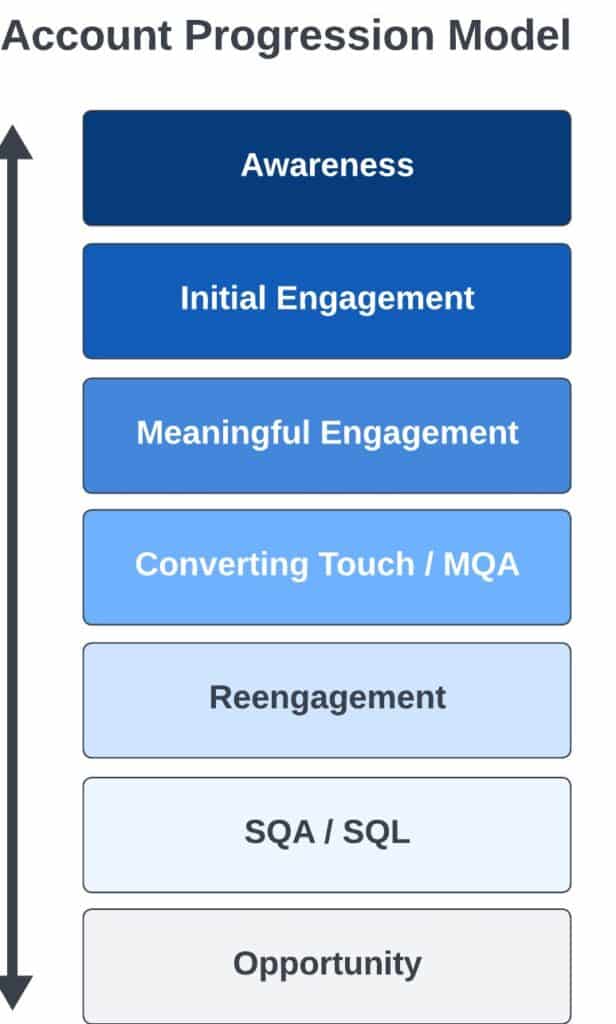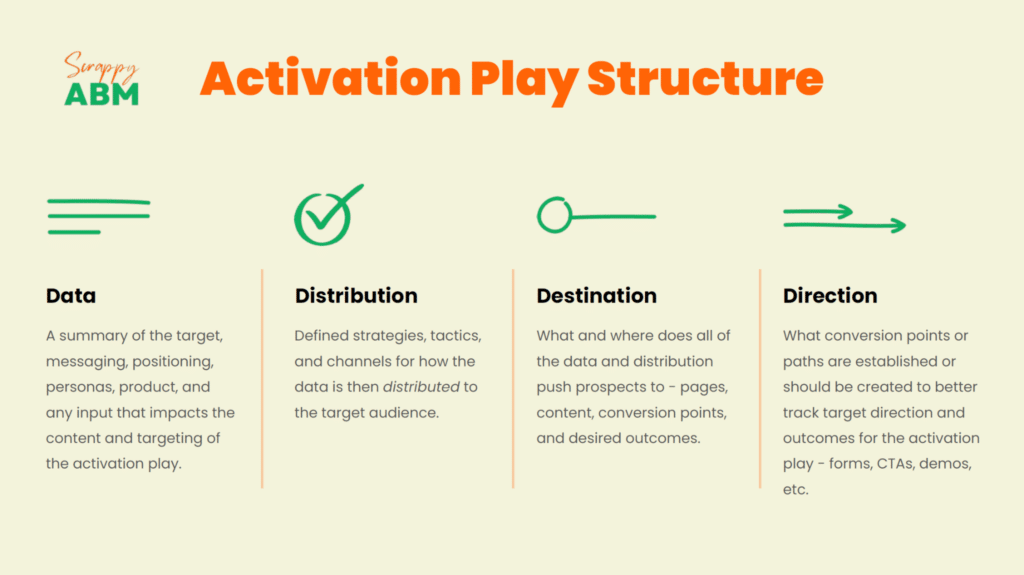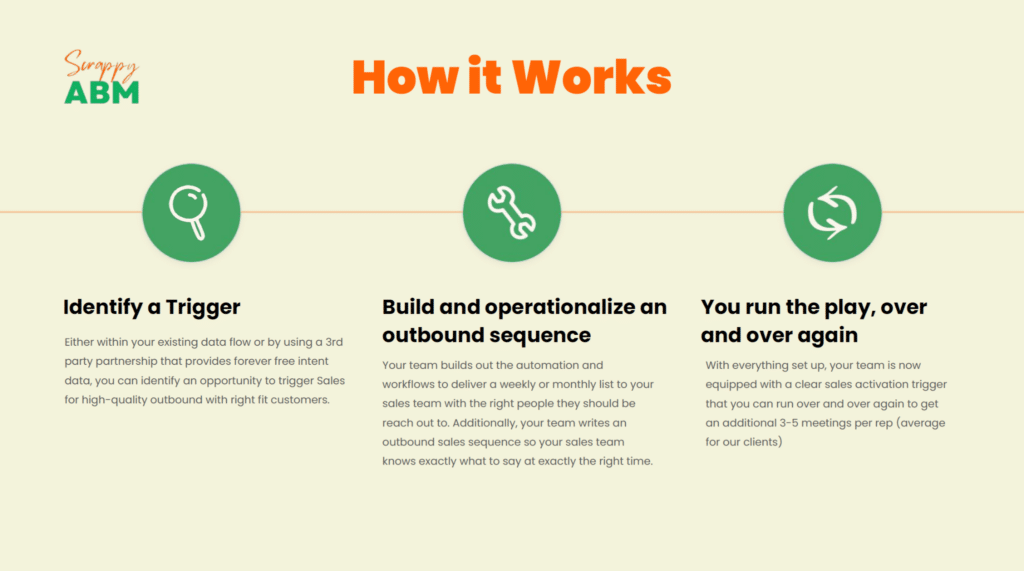Building your account-based marketing playbook can be super complicated, especially at first. But it doesn’t have to be.
We spoke to Mason Cosby of Scrappy ABM to learn how he builds repeatable, ROI-positive ABM programs. So, if you're trying to build your pilot ABM program with limited resources, this is for you.
And even if you're working with a huge budget, Mason's playbook enables you validate your model before you scale.
Editor's Note: The below sections have been written in the first person. Let's gooooo.
Why Use an ABM Playbook?
An ABM playbook simplifies the implementation of an ABM program. It maps out precise and repeatable tactics and processes you can use to build your ABM program, showing you what needs to be done at every stage of the process.
It can align your revenue team—marketing, sales, and customer success—with shared targets and goals when done correctly.
As a result, ABM ownership is entrenched across different functions within your organization. This collective ownership drives your ABM program’s success, increasing the chances of a broader buy-in within your organization.
How to Use the Scrappy ABM Playbook
The Scrappy ABM playbook helps you validate your ABM strategy before you scale.
It starts with a single sales activation play, allowing you to prove that a coordinated marketing and sales program can work. Then, you can add resources (technology and people).
In the sections below, I share how to build an ABM program using the Scrappy ABM Playbook. And how we've used this playbook to develop an ABM strategy for Medix, a leading provider of workforce solutions across the healthcare and life sciences industries.
Step 1: Account Selection and Targeting
Everything begins with identifying the type of accounts you want to target based on your ideal customer profile.
An ABM strategy is built on the fundamental principle of personalized engagement and tailored experiences for accounts and their individual buyers.
It involves identifying key target accounts, understanding their unique needs and pain points, and crafting highly targeted and personalized marketing initiatives to resonate with each account and member of the buying circle individually.
Your account selection process has two foundational elements: targets and triggers.
- Targets: Targeting involves two integral components—the ideal customer profile (ICP) and the personas. The ICP outlines the characteristics and needs of the ideal organizations at the account level, while the persona focuses on the specific individuals within those accounts.
Despite being an account-level strategy, your personas are especially crucial because they have the power to influence purchasing decisions. Identifying them allows you to tailor your ABM efforts to their preferences and challenges. Winning them over means you have advocates within your target account.
- Triggers: In the context of ABM, a trigger enrolls an account in a company’s defined strategy. Triggers can be a list created based on ICP and persona or an engagement signal indicating intent or an opportunity. The two types of triggers include:
- List Trigger: This involves creating and prioritizing target account lists by both the marketing and sales teams. These lists are curated based on predetermined criteria and strategic objectives, typically aligned with an ICP or Target Customer Profile (TCP).
- Signal Trigger: Signal Triggers involve the interpretation of engagement signals from various sources, including first, second, or third-party data. These signals indicate potential in-market activity or direct engagement with the organization's offerings, prompting personalized and timely outreach strategies.
Step 2: Account Progression
Account progression involves systematically guiding target accounts through various customer journey stages. The goal is to move these accounts forward by setting operational thresholds at each phase. When an account crosses a threshold, it either triggers progression, an activation play, or tracks the engagement. Here are the seven progression models for your scrappy ABM strategy.

#1. Awareness
In this phase, the goal is to establish either a state of “problem awareness” or “brand awareness.” If the target account is not already in a state of brand awareness, marketing and sales outreach should make target accounts aware of your company's existence.
But if they already know you, the goal shifts to making them problem-aware.
Problem awareness could mean making them aware of an issue in the market they’re unaware of. It could also mean connecting an awareness of the problem to you as the solution.
For this stage, we designed Medix’s playbook to rely on intent signals indicating customers’ early-stage research into electronic health records (EHR) systems in 6Sense.
Based on that, Medix shared thought leadership videos and downloadable content on platforms used by healthcare decision-makers.
These decision-makers may have some questions about the nature and depth of their in-market consideration. The goal is to highlight Medix's expertise and increase awareness of it as a leader in EHR advisory and staffing.
#2. Initial Engagement
Initial engagement is the first threshold an account typically crosses where you’ve captured some form of first (or recent) interaction. How this is defined differs from program to program.
But it can consist of something as simple as “n” number of ad clicks, your event presentation attendees, or any initial step that moves them out of an awareness phase into an identified engagement.
Given that the Medix team were participating at a conference around this time, I recommended segmenting attendees who engaged with Medix into high, moderate, and light engagement. Attendees who visited the Medix booth and participated in a demo were tagged as high-engagement prospects. Those attending Medix speaking sessions or collecting informational materials were considered moderate engagement prospects. Those who checked in at the Medix event space or got scanned were tagged as light engagement prospects.
#3. Meaningful Engagement
Meaningful engagement takes initial engagement further by tracking multiple intentional first-party engagement. Meaningful engagement could range from multiple page views and events attended to returning visitors and email click-throughs—or anything in between.
For Medix, meaningful engagement included multiple content downloads, attendance for something specific to Medix, or repeat visits to high-value pages. Based on any of these signals, sales sent customized content that addressed each lead's unique challenges and questions. Generally, the primary content theme at this stage revolved around tailored solutions and personal guidance through the complexities of healthcare staffing and EHR implementation.
While not a perfect science, the goal is to create enough of a compelling conversion path in the initial engagement stage that it progresses the engagement further or broadens the audience within an account to multiple individuals.
#4. Converting Touchpoint (MQA)
Moving an account into some form of MQA stage is the first real sign of life that you’re connecting with individuals at an account. Basically, if you can connect a name to a signal (or multiple names with signals), you’re hitting an MQA. This is not a cry for a sales demo, but it’s something you can capitalize on. This also typically preempts some form of sales ask or the final step of someone at an account attempting to engage before they truly convert.
#5. Reengagement
Reengagement is used circumstantially. In theory, the goal here is to nurture or reengage an account that has either gone cold or you’ve created an additional step between an ask for sales demos. This could be anything from remarketing with social proof or contacting a partner to stir up the conversation after things seem to die off.
In the case of Medix, a lead is cold when there’s no response after six months of prior engagement. I recommended reaching out to emphasize advancements or changes in Medix's offerings since the last contact or highlighting new solutions to their challenges. You can also use shifts in market conditions or macro-economic changes as a reason to reach out.
#6. SQA/SQL
After this much engagement, you will reach the asking phase. Follow a target until they say, “Leave me alone” or “Let’s go.” My Dad always said, “You’ll never know unless you ask.”
#7. Opportunity
An opportunity is created once leads are qualified. If an account moves into this phase, you can count the general prospect journey as successful.
However, progression is not linear, and not every stage is necessary. For example, an account can move from awareness to opportunity, skipping all the other stages. This progression model can also be adapted based on your product/service and customer buying behavior.
Step 3: The 4D Activation Plays
Activation plays are the repeatable processes for when Sales or CS becomes involved in specific customer conversations.
They include strategic procedures designed to engage and nurture target accounts effectively.
We developed the 4D activation play at Scrappy ABM as a simple structure that can be used to build an ABM strategy, even with limited resources.
This is where you begin if your account selection and progression models are already in place.
The 4D activation play covers four stages: data, distribution, destination, and direction. These four things can help you kick off your ABM program with limited resources.

#1. Data
The data stage lays the groundwork for an activation play by providing a comprehensive summary of essential elements that inform content and targeting strategies.
This includes detailed insights into the target audience, messaging, positioning, personas, and product offerings. By analyzing this data, you gain a nuanced understanding of the target's needs and preferences, allowing you to decide the content type that will resonate with them.
For example, I used the 4D activation plays for my session at the 2024 B2BMX conference to create 26 sales opportunities. Three hundred forty-eight people registered for my session. In the event app, you could see their company, title, and the sessions they attended. So, my entire data set was present within the app, which informed the participants I targeted.
#2. Distribution
In this stage, you define the strategies, tactics, and channels you’d use to disseminate the data compiled in the previous stage to your target audience.
This involves selecting the most appropriate channels and deploying tactics that align with the preferences and behaviors of the target accounts.
Whether through digital platforms, email campaigns, social media, calls, or other avenues, your distribution strategies should aim to reach prospects where they are most receptive to your message.
For the #B2BMX event, I also connected with everyone on the event app and sent a message based on who attended my session and had the right title. Once someone accepted my connection to the app, I followed up with a LinkedIn connection request for distribution channels.
#3. Destination
The destination stage outlines the specific places the distribution efforts aim to guide prospects toward.
This could encompass various assets or locations such as ABM landing pages, content, specific conversion points, physical location, or any desired landing spot. You facilitate engagement, interaction, and conversion by strategically directing prospects to these destinations. This ensures that every touchpoint contributes meaningfully to the account progression journey.
In practice, the message I sent to my event attendees was a thank you for attending and offered time to connect 1:1 during the conference if they wanted more specific advice. Then, I provided my calendar link as a destination if they wanted to connect 1:1 after the conference.
#4. Direction
This stage outlines and establishes clear conversion points or paths to track and guide targets within the activation play.
This could involve implementing forms, calls-to-action, demos, or other engagement triggers to facilitate seamless progression through the buyer's journey.
By providing clear direction and pathways, you enhance visibility into prospect behavior and effectively optimize efforts toward achieving desired outcomes.
In my case, I looked at the number of meetings scheduled to determine if these accounts were moving toward becoming customers. We scheduled more than 26 conversations. But out of our conversations, 26 said, “I'd love to explore working with you and learning more.”
Actioning the ABM Playbook

Activation plays can be this simple in practice, so we advocate starting with them.
If you’re wondering where to start, I recommend starting with a closed-lost campaign.
These prospects know the problem and that you’re a solution. They likely didn’t move forward because of an objection you should hopefully know. On top of that, you also already know the buying committee, so you know who to go after and why they were looking for a solution in the first place.
When you combine all this information, closed-lost is where you have the best data on these accounts. Plus, you have no risk with closed lost leads. They already said no; the worst they can do is say no again.
Kickstart Your ABM Program With Scrappy ABM Playbook
Scrappy ABM creates a framework that simplifies building an ABM program with limited resources. It involves:
- Building a list of target accounts and persona.
- Identifying triggers that show when your accounts move from one stage to the next.
- Creating personalized messaging that matches the target’s pain point.
- Selecting channels to distribute your content to your target audience.
- Choosing where to push prospects to, e.g., product-specific landing pages.
- Directing them toward your desired outcome (conversion).
You can start at any point, depending on your organization. Plus, it doesn’t take a long time to build.
If you need expert guidance on your scrappy ABM journey, contact Scrappy ABM or download the Scrappy ABM playbook. And if you’re looking for more resources on ABM, be sure to subscribe to The CMO’s newsletter for marketing leaders for more ABM expert insights.


